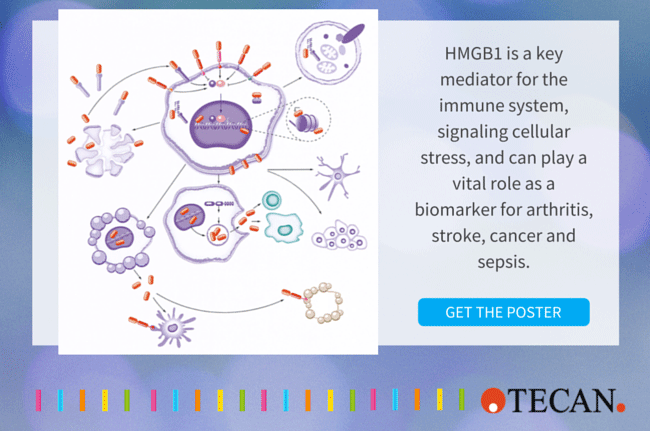By Oliver Schmidt
In the first article in this series, we looked at how HMGB1 has taken an increasingly important position as a key mediator in the immune response and as such plays a major role in a large number of diseases – from sepsis to cancer. As Professor Helena Erlandsson Harris, a pioneer in HMGB1 research, says, “I am convinced that the next step will be even better data to demonstrate the usefulness of HMGB1 as a prognostic/diagnostic biomarker. This has been hampered by the need to understand the isoforms that control different functions and also the methods for measuring HMGB1. It would be even better if HMGB1 detection were included in larger biomarker panels.” HMGB1 has indeed been included as a necessary biomarker in consensus guidelines for the detection of immunogenic cell death. The question is how to measure it. In this article, we will look at the development of increasingly sensitive, reliable and easy-to-use assays for clinical research and routine use and how this has been complicated by the need to resolve the isoforms, and also overcome interference caused by auto-antibodies and other proteins that naturally interact with HMGB1 to modulate its function.
The move from western to ELISA
Western blotting has been traditionally included in the detailed analysis of protein structure and function. In the case of analyzing HMGB1, this could involve an initial crude separation step using, for example, heparin-Sepharose, followed by separation by sodium dodecyl sulfate–polyacrylamide gel electrophoresis (SDS-PAGE) and transfer to a membrane that is probed with labeled antibodies. Certainly the denaturation and resolution afforded by SDS-PAGE enables detection of many forms of HMGB1, but the method is laborious and only semi-quantitative, so researchers naturally turned to ELISA as an alternative.
Developing an ELISA to measure HMGB1 would, of course, offer a number of advantages over western blotting, including ease of use and the high throughput needed to meet increasing analytical demands as the importance of HMGB1 in many diseases became known. The challenge was to develop antibody reagents to build sensitive assays for a protein that is central to the mammalian immune response and with a range of modifications that are critical to its function.
Creating effective antibodies against HMGB1 is a fight against nature. As Marco Bianchi, a leading scientist in the HMGB field and founder of HMGBiotech (www.hmgbiotech.eu/) puts it, “HMGB1 is one of the pillars of the immune system, so whenever you try use the immune system to create reagents against HMGB1 you are asking the immune system to make antibodies against one of the main cogs in the immune machinery.”
Assay developers usually aim to use highly specific monoclonal antibodies in ELISA, but it has been a fifteen-year struggle just to develop the three monoclonal antibodies that exist so far, and they all have a low affinity for HMGB1. Getting ELISAs based on monoclonal antibodies onto the market is a clear goal for suppliers. Meanwhile, the resolution of the leading ELISA for total HMGB1 is still based on polyclonal capture antibodies raised in chickens, although the detection antibody, which identifies both HMGB1 and HMGB2, is monoclonal. Birds have a slightly different HMGB1 with a few amino acid changes and mammalian HMGB1 is better recognized by the avian immune system.
The challenge of interference
Even high-performance ELISAs for HMGB1 are faced with challenges, including interference. In their pioneering work on ELISA interference, Vilma Urbonaviciute, at IZKF Research Group 2, Erlangen, Germany, and her co-workers found that ELISA detected lower levels of HMGB1 than immunoblotting. They suspected that the cause might be the IgG and IgM antibodies that bound to HMGB1 in most sera and plasma samples they investigated, including those from healthy individuals. Considering the multiple functions of HMGB1, it is perhaps not surprising that measurement in serum and plasma can be severely affected by natural interactions with a large range of molecules. For example, HMGB1-binding antibodies may well play an important role in biological functions, such as limiting overwhelming cytokine release as a result of tissue damage or sepsis. Added to that, the activity of HMGB1 largely relies on its ability to form biologically active complexes with cytokines such as IL-1beta, with lipopolysaccharide, or with CpG oligonucleotides. Interference can be particularly problematic in diseases that have a high prevalence of autoantibodies against HMGB1 in patients with autoimmune diseases, including systemic lupus erythematosus (SLE) and rheumatoid arthritis (RA).
To solve the interference problem in ELISA, Stéphanie Barnay-Verdier and her colleagues denatured complexes by treating samples with perchloric acid (PCA) before measuring. This significantly improved HMGB1 concentration measurements in, for example, samples of plasma from patients with septic shock where antibodies caused interference. PCA is, however, highly toxic.
Exploiting the DNA-binding ability of HMGB1
In a novel approach, Gaillard and co-workers met the need for an interference-free assay of HMGB1 by using EMSA (electrophoretic mobility shift assay), based on high affinity binding of hemicatenated DNA loops (hcDNA) to HMGB1. The band-shift assay method involves separating the DNA-protein complexes formed between HMGB1 and radiolabeled hcDNA by electrophoresis on non-denaturing polyacrylamide gels followed by visualization by autoradiography. Interference could be eliminated using PCA. The researchers concluded that the method “compares favorably with ELISA in terms of sensitivity and background, and is less prone to interference from masking proteins in serum”. The method, however, is comparable with western blotting in being both complex and low throughput. It is also unable to resolve isoforms.
The resolving power of LC/MS
Despite all the advances made in ELISA, which remains the dominant method for total HMGB1 measurement, antibody development has yet to deliver the specificity required to resolve and measure isoforms resulting from post-translation modifications such as acetylation and oxidation that determine the location and function of HMGB1. Control of translocation, release, and activity may vary depending on context, but oxidative stress is probably a common regulatory mechanism. For example, reactive oxygen species (ROS) promote HMGB1 translocation and release in activated immune cells or injured cells. The redox status of HMGB1 also influences its extracellular activity, including immunity and autophagy.
Isoforms of HMGB1 can be identified in serum, saliva, and cell culture medium by nuclear magnetic resonance (NMR) spectroscopy and liquid chromatography-tandem mass spectrometry (LC/MS), but LC/MS is the most commonly used analytical method. In fact, one laboratory dominates this field – that of Daniel Antoine, at the MRC Centre for Drug Safety Science, Department of Pharmacology & Therapeutics, Liverpool University, UK. Researchers around the world routinely send him samples for analysis by a method that offers exquisite resolution and quantification of all forms of HMGB1. For example, in a study on the toxicological response associated with the hepatotoxin acetaminophen (APAP) in the mouse, he and his colleagues could identify and characterize several molecular forms of HMGB1 that are linked to the mechanisms and pathological changes induced by APAP. These included hypoacetylated HMGB1 (necrosis indicator) in serum that was strongly correlated with cell death.
In another example, Professor Helena Erlandsson Harris and her colleagues at Karolinska Institute, Sweden, who work on juvenile idiopathic arthritis collaborated with Daniel Antoine’s lab to tease out the detailed involvement of HMGB1 post-translation modifications (PTMs) in the inflammation process. They could demonstrate, for example, a strong correlation between total HMGB1, as determined by ELISA, and nuclear location sequence 2 (NLS2) hyperacetylation, which indicated active release of HMGB1.
LC/MS does indeed provide exquisite resolution of HMGB1 isoforms, but it offers very low throughput and is highly complex, as indicated by the fact that only one lab in the world truly masters the method.
The vision of detecting isoforms with ease
The Holy Grail in HMGB1 research and translation to the clinic is a sensitive, easy-to-use and high throughput assay capable of resolving isoforms. The hope is that more specific antibodies can be generated to enable the development of isoform-specific ELISAs. Meanwhile, the current analytical methods represent a compromise between isoform resolution (LC/MS) and ease of use/high throughput measurement of total HMGB1 (ELISA) with the possibility of reducing interference (PCA-ELISA).
Analysis using ELISA is the first step in determining total HMGB1. Assay robustness is crucial and demands stable antibody preparations. One kit has established a strong position in HMGB1 research, partly because of its robustness. In the last of this three-part series on HMGB1 we will look at the performance of the HMGB1 ELISA Kit from IBL and why it is regarded as the gold standard.

Further reading
Antoine DJ et al. High-mobility group box-1 protein and keratin-18, circulating serum proteins informative of acetaminophen-induced necrosis and apoptosis in vivo. Toxicol Sci. 2009 Dec;112(2):521-31. [PMID: 19783637]
Barnay-Verdier S et al. PCA-ELISA: a sensitive method to quantify free and masked forms of HMGB1. Cytokine. 2011 Jul;55(1):4-7. [PMID: 21474328]
Gaillard C et al. A high-sensitivity method for detection and measurement of HMGB1 protein concentration by high-affinity binding to DNA hemicatenanes. PLoS One. 2008 Aug 6;3(8):e2855. [PMID: 1868275]
Ilmakunnas M et al. High mobility group box 1 protein as a marker of hepatocellular injury in human liver transplantation. Liver Transpl. 2008 Oct;14(10):1517-25. [PMID: 18825712]
Kepp O et al. Consensus guidelines for the detection of immunogenic cell death. Oncoimmunology. 2014 Dec 13;3(9). [PMID: 259416]
Lundbäck P et al. Characterization of the Inflammatory Properties of Actively Released HMGB1 in Juvenile Idiopathic Arthritis. Antioxid Redox Signal. 2016 Apr 20;24(12):605-19. [PMID: 25532033]
Urbonaviciute V et al. Factors masking HMGB1 in human serum and plasma. J Leukoc Biol. 2007 Jan;81(1):67-74. [PMID: 17060363]
About the author

Oliver Schmidt
Oliver Schmidt is product manager for research reagents, neurodegeneration, and bone and mineral products at TECAN-IBL in Hamburg with more than 10 years’ experience in bringing these products to the Life Science and academic community. He studied Environmental Engineering at the Technical University of Hamburg-Harburg and joined TECAN-IBL in 2005.











